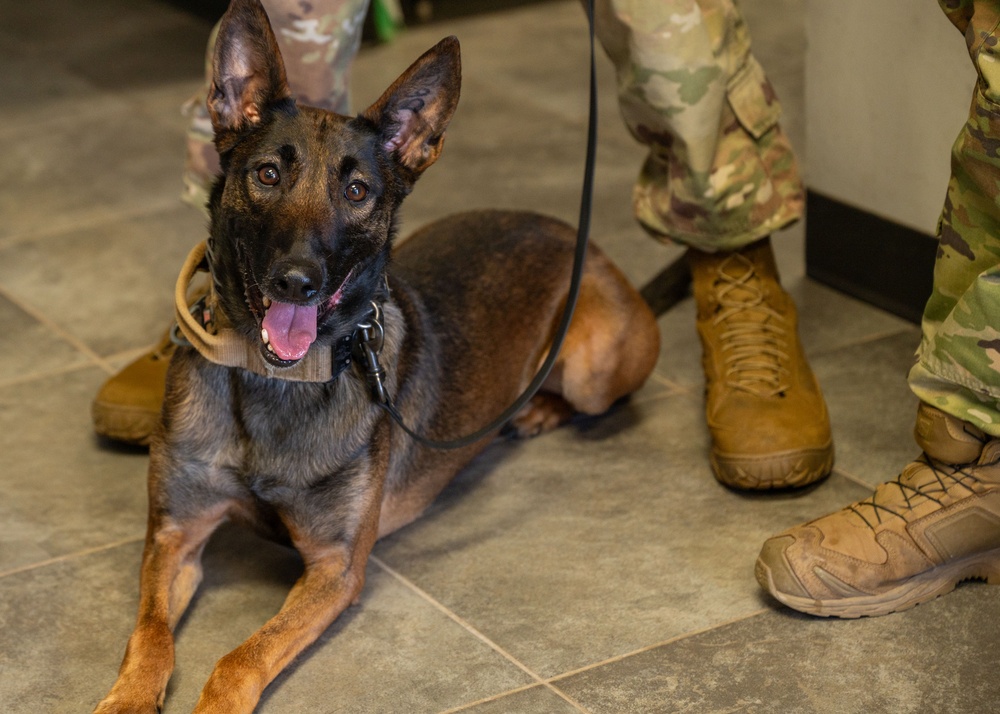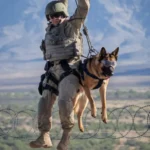In a dynamic showcase of teamwork and expertise, the 52nd Security Forces Squadron (SFS) hosted an international training seminar designed to enhance the skills of military working dog (MWD) teams.
Over 25 dog-handler pairs participated in rigorous exercises that tested their communication, command skills, and the dogs’ abilities to detect explosives, locate suspects, and find missing persons across diverse environments.

U.S. Army Sgt. Aaron Vinson, operations noncommissioned officer with the 100th Military Police (Military Working Dog) Detachment, emphasized the significance of the training: “The knowledge learned from the events our teams were run through today will allow us to set forth a training plan that will strengthen our capabilities over time.”
This commitment to continuous improvement reflects the evolving demands placed on military working dogs and their handlers.
The seminar featured multiple simulations, including explosive scent detection both outdoors and in low-light conditions, which required the use of night vision goggles.
Scenarios also included search and rescue missions and suspect apprehension exercises. Air Force Staff Sgt. Nathan Fortmayer, a trainer with the 52nd SFS/MWD Section, highlighted the importance of collaboration: “As the hosts, we wanted to ensure we provided teams with realistic scenarios that dog teams could very well face.
This way, they not only receive training but also learn from each other in the process.”
Handlers also received invaluable instruction in canine tactical combat casualty care, thanks to U.S. Army veterinarians and animal care technicians from the Veterinary Readiness Activity Rheinland-Pfalz.
Using the Advanced K9 Medical Trainer mannequin, handlers practiced essential first-aid techniques designed to simulate real-life emergencies, reinforcing their ability to care for their canine partners in critical situations.
One poignant moment from the training was captured as U.S. Air Force Staff Sgt. Shanna McCarter guided MWD Mojito towards the scent of simulated explosives.
This hands-on experience underscored the dual role of these working dogs: as invaluable partners in military operations and as cherished companions.
Fortmayer expressed this sentiment clearly: “To us, these dogs are much more than dogs—they’re partners. We care about them the same way we would any other human because they defend us with their lives. It’s critical we can help them when they are most vulnerable.”
The training brought together various military and police units, including the 86th Security Forces Squadron from Ramstein Air Base, the U.S. Army 100th MP (MWD) Detachment from Miesau Army Ammunition Depot.
And members from Germany’s Bundeswehr, Rhineland-Pfalz and Saarland Polizei, as well as the Search and Rescue departments in Trier and Grand Ducal Police in Luxembourg.
This diverse collaboration not only enhanced individual skills but also fostered international camaraderie and understanding among the teams.
Contents
Conclusion
In conclusion, the 52nd SFS’s international training seminar exemplified the dedication and commitment of military working dog teams to improving their operational effectiveness while strengthening the bonds between handlers and their canine partners.
As these teams continue to face evolving challenges, such collaborative training events will be crucial in preparing them for the tasks ahead.
FAQ’s
What was the purpose of the international military working dog training seminar?
- The seminar aimed to enhance the skills of military working dog teams by challenging their communication and command abilities, as well as reinforcing their capacity to detect explosives, locate suspects, and find missing persons in various environments.
How many dog-handler teams participated in the training?
- Over 25 working dog teams participated in the seminar, representing various military and police units.
What types of training exercises were included in the seminar?
- The training included explosive scent detection in outdoor and low-light conditions, search and rescue missions, suspect apprehension exercises, and hands-on instruction in canine tactical combat casualty care.
Who provided instruction in canine tactical combat casualty care?
- Instruction was provided by U.S. Army veterinarians and animal care technicians from the Veterinary Readiness Activity Rheinland-Pfalz, who guided handlers in essential first-aid techniques for their dogs.
Which units participated in the training seminar?
- Participants included the 86th Security Forces Squadron from Ramstein Air Base, the U.S. Army 100th MP (MWD) Detachment from Miesau Army Ammunition Depot, the German Bundeswehr, and local police forces from Rhineland-Pfalz, Saarland, Trier, and Grand Ducal Police in Luxembourg.
What is the significance of training working dogs in realistic scenarios?
- Training in realistic scenarios allows dog-handler teams to prepare for the challenges they may face in the field, improving their effectiveness and safety during actual missions while also fostering teamwork and learning among different units.







